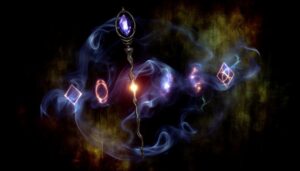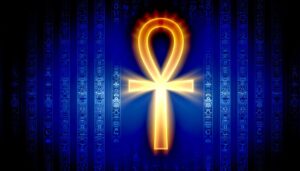Celtic Trinity Knot Symbol: What Does It Represent?
The Celtic Trinity Knot, or Triquetra, is a profound symbol rooted in ancient Celtic culture. It embodies the concept of triadic unity, reflecting the interconnection between earth, sea, and sky, or the life cycle of birth, death, and rebirth.
Archaeological finds show its prominence in historical art, reinforcing its enduring legacy. The knot was later adapted by Christians to represent the Holy Trinity, facilitating its integration with Celtic paganism.
This emblem of interconnectedness continues to influence modern jewelry, art, and spiritual beliefs, symbolizing eternal connections and unity. For an in-depth understanding, explore its multifaceted historical and cultural contexts further.
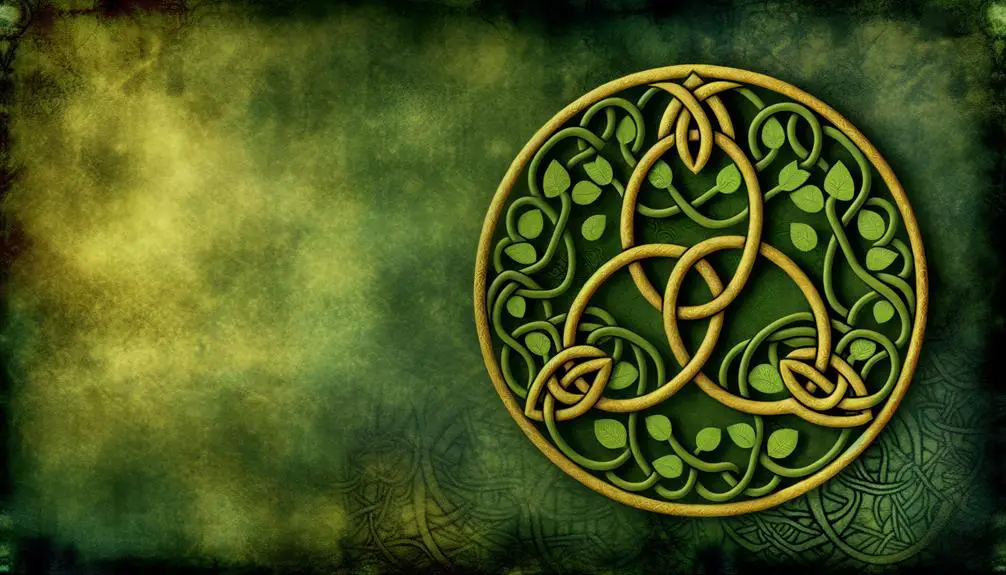
Key Takeaways
- Represents the triadic themes in Celtic cosmology, such as earth, sea, and sky.
- Symbolizes unity and interconnectedness in nature and spirituality.
- Associated with the Christian Holy Trinity, embodying divine unity and eternity.
- Reflects the cyclical nature of life, including birth, death, and rebirth.
- Emblematic of Celtic heritage, ancestral lineage, and enduring cultural principles.
Historical Origins
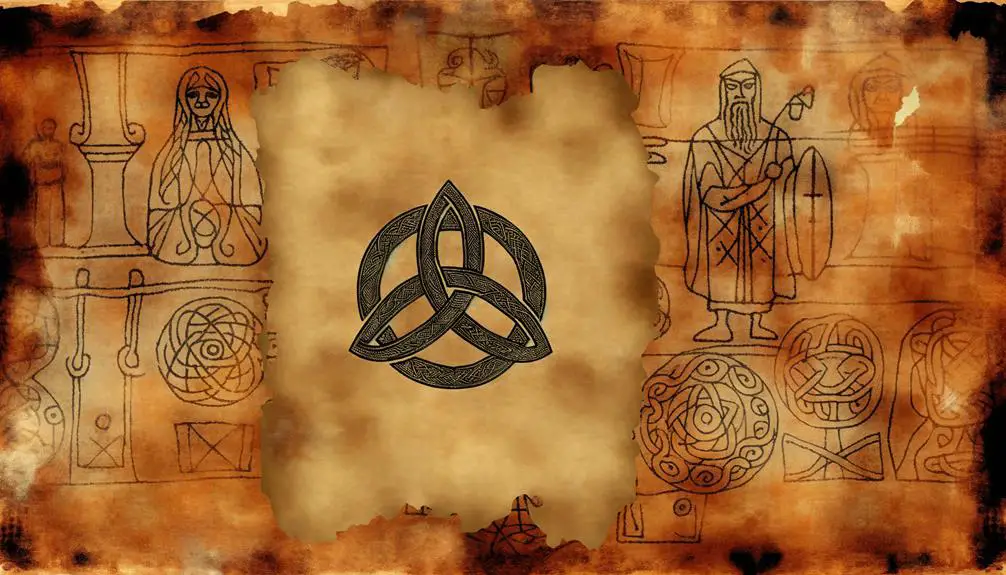
The historical origins of the Celtic Trinity Knot, also known as the Triquetra, can be traced back to ancient Celtic culture, where it was prominently featured in various forms of art and religious symbolism.
This intricate design, characterized by three interlocking loops, appears frequently in Celtic manuscripts, stone carvings, and metalwork dating back to the early medieval period.
Its symmetrical form is often associated with triadic themes prevalent in Celtic mythology and cosmology, suggesting a deep spiritual resonance.
The Triquetra's geometric precision and recurring presence in archaeological finds demonstrate its significance within the societal and religious frameworks of the Celts.
This symbol's endurance across centuries highlights its integral role in conveying complex philosophical and theological concepts through visual artistry.
Celtic Cultural Significance
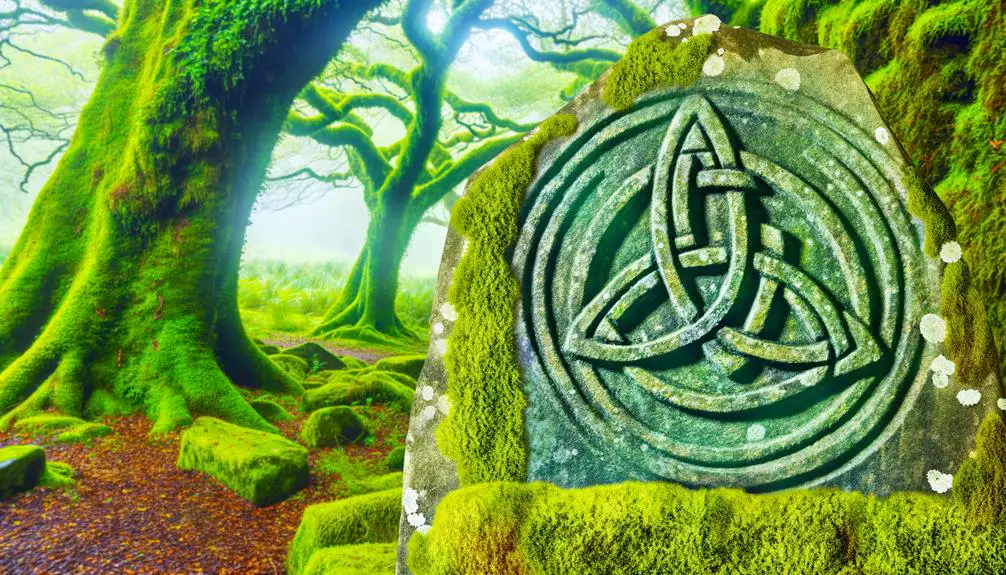
In the context of Celtic culture, the Trinity Knot embodies a multifaceted symbol representing the interconnectedness of life, spirituality, and the natural world. Its intricate design captures the essence of Celtic beliefs and societal values. Historically, it has been interpreted through various lenses, emphasizing different aspects of its cultural significance:
- Unity: The unbroken lines exemplify eternal life and interconnectedness.
- Triad Concept: Reflecting the importance of triplicity in Celtic cosmology.
- Heritage: A symbol of identity and ancestral lineage, linking generations.
- Natural Elements: Representing earth, water, and sky, the core elements of nature.
These interpretations underscore the Trinity Knot's role as a profound cultural emblem, encapsulating the enduring principles and philosophies of the Celtic people.
Spiritual Interpretations
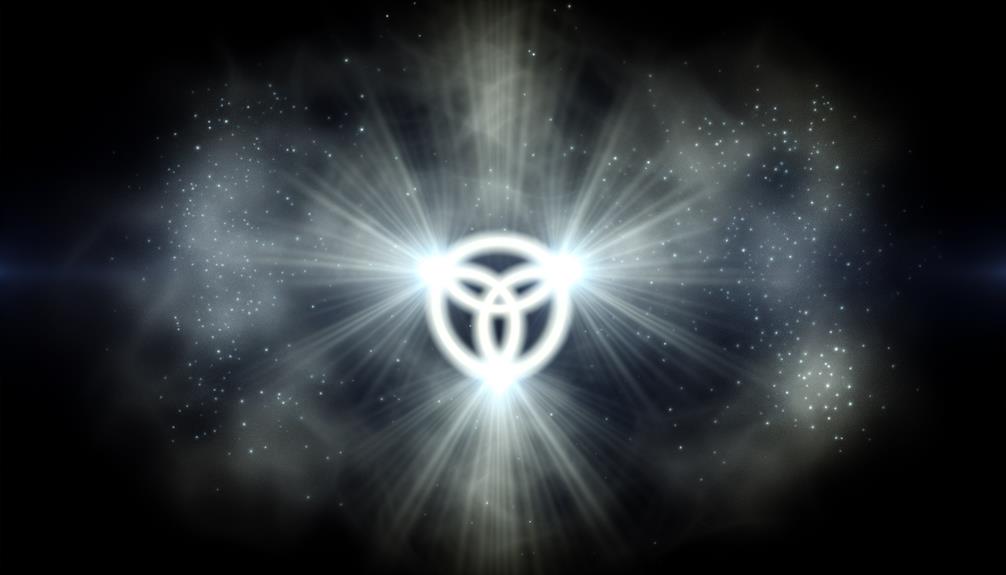
In spiritual contexts, the Celtic Trinity Knot is frequently associated with the Christian Holy Trinity, symbolizing the Father, Son, and Holy Spirit in an unbroken form, reflecting divine unity and eternity.
Additionally, it embodies the cyclical nature of life, encompassing birth, death, and rebirth, which aligns with broader metaphysical beliefs about the continuity of existence.
This dual interpretation underscores the symbol's profound resonance across both religious and existential dimensions.
Connection to Holy Trinity
Rooted in Christian symbolism, the Celtic Trinity Knot—also known as the Triquetra—profoundly embodies the Holy Trinity, representing the Father, the Son, and the Holy Spirit. This intricate symbol is not merely decorative but carries deep theological significance. It encapsulates the concept of three distinct entities that are unified at their core.
Key aspects of its connection to the Holy Trinity include:
- Unity in Diversity: Each loop signifies a distinct divine person, yet they are interconnected, symbolizing the indivisibility of God.
- Eternal Continuity: The unbroken line reflects the timeless nature of the divine.
- Spiritual Protection: Historically, it has been used as a protective charm against evil.
- Interwoven Faith: Its continuous form mirrors the interconnected nature of faith, life, and spirituality.
Cycle of Life
The Celtic Trinity Knot also profoundly represents the cyclical nature of life, emphasizing the interconnectedness of birth, death, and rebirth in spiritual interpretations. This symbol highlights the seamless flow and continuity within life's stages, encouraging a holistic understanding of existence. Each loop of the knot signifies a distinct phase, yet they are bound together without beginning or end.
| Stage | Symbolic Representation | Spiritual Interpretation |
|---|---|---|
| Birth | New Beginnings | Innocence and Potential |
| Life | Growth and Experience | Learning and Development |
| Death | Endings | Transformation and metamorphosis |
This triadic unity encapsulates the essence of life's journey, offering a profound reflection on the perpetual cycle that governs all beings. Through this lens, the Trinity Knot becomes a powerful emblem of spiritual continuity and resilience.
Symbolism in Art
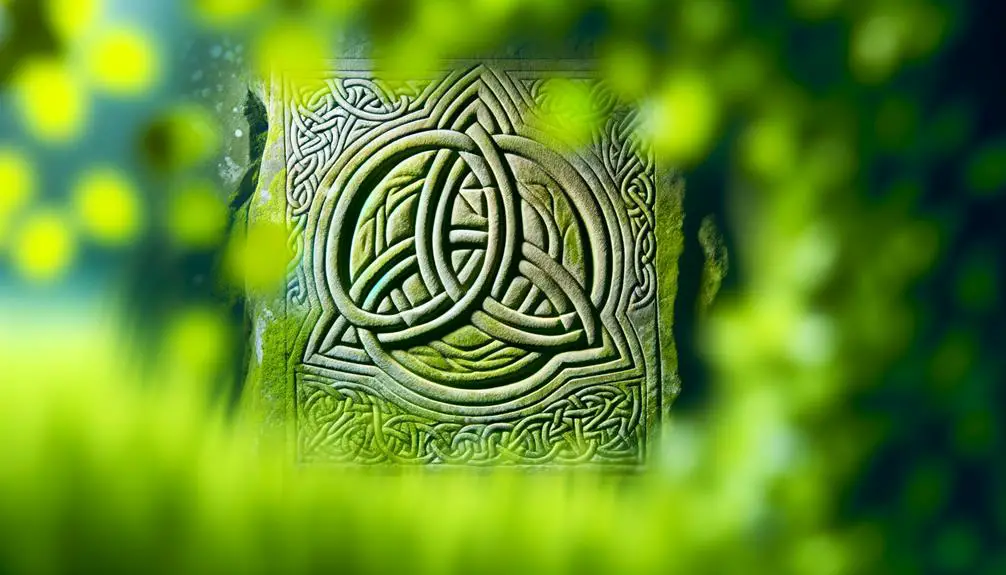
The Celtic Trinity Knot has been a prominent feature in ancient artistic representations, often found in stone carvings, illuminated manuscripts, and metalwork, symbolizing various triadic concepts including life, death, and rebirth.
In contemporary art, this symbol has been reinterpreted in diverse mediums such as digital art, jewelry design, and tattoos, reflecting modern values and aesthetics while retaining its historical essence.
Analyzing these interpretations offers insight into how the Trinity Knot's enduring legacy continues to inspire and evolve within different artistic contexts.
Ancient Artistic Representations
Ancient artistic representations of the Celtic Trinity Knot, or Triquetra, often intertwine with themes of spiritual interconnectedness, reflecting its profound symbolic significance in early Celtic culture. These intricate designs frequently appeared in various forms of artistic expression, each embodying the trinity concept.
- Manuscripts: Illuminated manuscripts like the Book of Kells feature the Triquetra, illustrating its religious and artistic prominence.
- Stone Carvings: Many ancient stone crosses and monuments are adorned with the Trinity Knot, symbolizing eternity and unity.
- Jewelry: Celts used the Triquetra in jewelry, signifying eternal life and interwoven spiritual paths.
- Metalwork: Intricate metal artifacts, such as brooches and chalices, often incorporate the Trinity Knot, emphasizing craftsmanship and spiritual symbolism.
These representations underscore the interconnectedness central to Celtic belief systems.
Modern Interpretations in Art
In contemporary art, the Celtic Trinity Knot has been reimagined to convey modern interpretations while maintaining its rich historical symbolism. Artists today integrate the knot into a diverse array of mediums, from digital art to sculpture, emphasizing themes of unity, eternity, and interconnectedness.
While the traditional three-loop design remains, its contextual application often expands to include modern narratives such as environmental sustainability, gender equality, and global interconnectedness. Additionally, the knot's endless looping paths resonate with contemporary discussions on life's cyclical nature and the interconnectedness of all beings.
Christian Adaptation
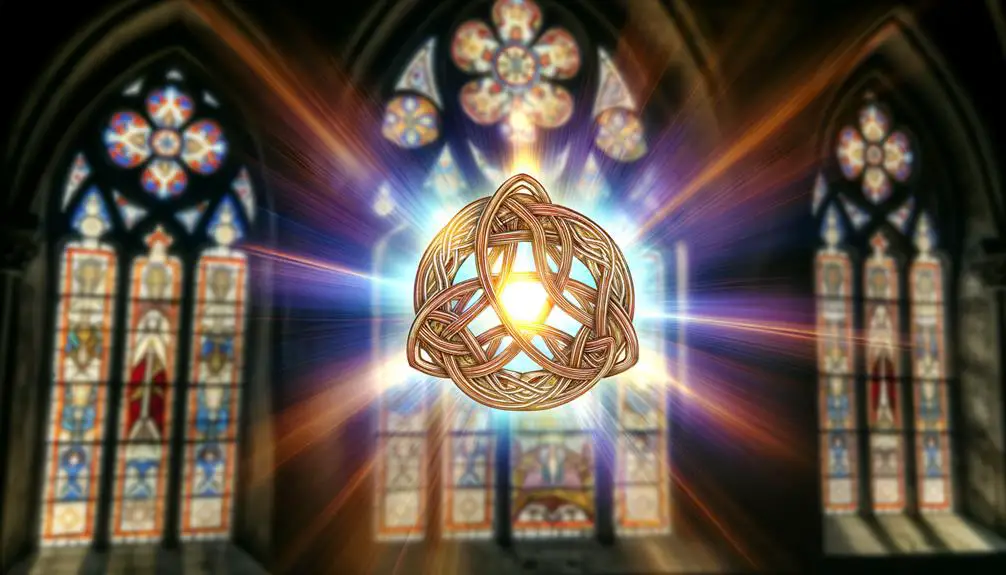
One significant aspect of the Celtic Trinity Knot's evolution is its adaptation by early Christian missionaries. They reinterpreted the symbol to align with the Holy Trinity's theological framework, facilitating the symbol's acceptance among the pagan Celts while reinforcing Christian doctrines.
The Trinity Knot came to represent:
- Father, Son, and Holy Spirit: Emphasizing the core Christian belief in one God existing in three persons.
- Eternal Life: The knot's continuous loop symbolized the perpetual nature of the divine.
- Unity and Equality: Each interlocking loop conveyed the co-equal and co-eternal nature of the Trinity.
- Spiritual Interconnection: Illustrating the relationship between God and humanity.
Modern Uses
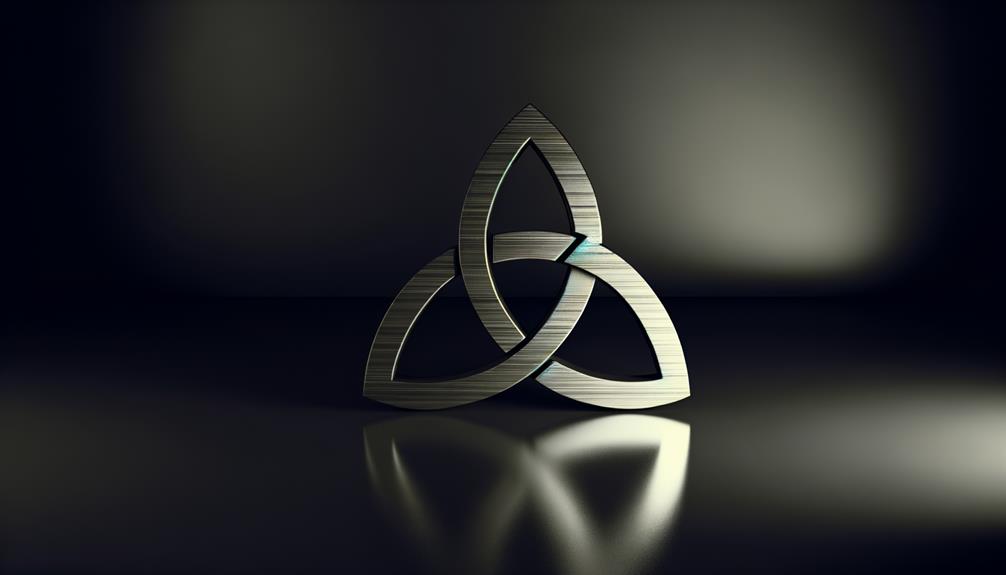
As the Celtic Trinity Knot evolved through its Christian adaptation, its contemporary applications have expanded to encompass a diverse array of cultural, artistic, and personal expressions.
In the domain of jewelry, the Trinity Knot symbolizes eternal love and interconnectedness, often featured in engagement rings and pendants.
Artists and designers incorporate the symbol into textiles, tattoos, and home décor, celebrating both its aesthetic appeal and its deep-rooted symbolism.
Additionally, corporate logos and branding strategies sometimes employ the Trinity Knot to evoke notions of heritage, continuity, and unity.
In the field of spiritual practices, it serves as a meditative focal point, representing the triadic nature of existence.
These modern uses reflect the symbol's enduring relevance and versatility in contemporary society.
Variations and Styles
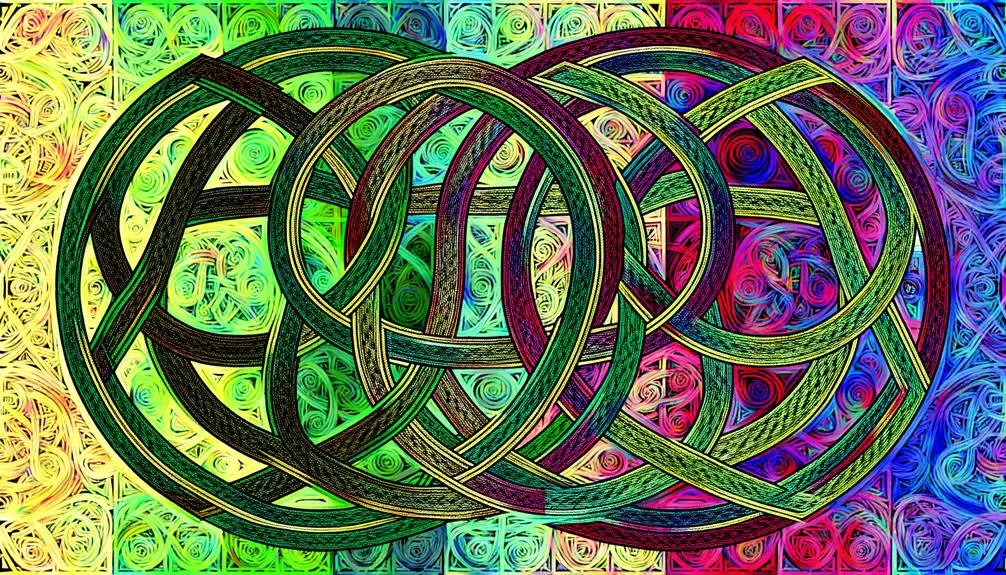
Exploring the variations and styles of the Celtic Trinity Knot, one observes an array of traditional knot designs that have been meticulously preserved through generations.
Modern interpretations often blend these ancient motifs with contemporary aesthetics, creating a dynamic fusion that resonates across different cultures.
In addition, the cultural significance of these variants underscores the knot's enduring appeal and evolving symbolism in various contexts.
Traditional Knot Designs
Traditional Celtic knot designs encompass a rich tapestry of variations and styles, each carrying distinct symbolic meanings and historical significance. These intricate patterns, often without a clear beginning or end, symbolize eternity and interconnectedness.
Key traditional designs include:
- Triquetra: Also known as the Trinity Knot, representing the tripartite nature of existence—earth, sea, and sky.
- Dara Knot: Symbolizing strength and inner wisdom, derived from the Gaelic word 'Doire,' meaning oak tree.
- Celtic Cross: Merging Christian symbolism with ancient Celtic design, signifying faith and unity.
- Shield Knot: Used for protection and warding off evil spirits, typically featuring a square or circular shape with interlacing lines.
Each knot embodies a unique facet of Celtic heritage, reflecting the culture's deep reverence for nature, spirituality, and eternity.
Modern Interpretations
Building upon the rich heritage of traditional Celtic knot designs, modern interpretations have emerged that blend historical symbolism with contemporary aesthetics, creating variations that resonate with today's cultural and artistic sensibilities.
Contemporary artists and designers often incorporate the Trinity Knot into jewelry, tattoos, and digital art, adapting its form to suit modern tastes. These adaptations may include streamlined, minimalist versions or intricate patterns interwoven with other symbols.
Additionally, the use of diverse materials such as metals, wood, and fabrics reflects a fusion of ancient craft with modern technology. This evolution highlights the enduring relevance of the Trinity Knot, offering a bridge between past and present while allowing for personalized expressions of cultural heritage.
Cultural Significance Variants
The cultural significance of the Celtic Trinity Knot has diversified over time, manifesting in various styles and interpretations that reflect the evolving nuances of different communities and historical contexts. This intricate symbol, originally rooted in Celtic mysticism, has been adapted to convey a multitude of meanings.
- Religious Symbolism: In Christianity, the Trinity Knot is often used to represent the Holy Trinity, symbolizing the Father, Son, and Holy Spirit.
- Celtic Heritage: Many people use the knot to express pride in their Celtic ancestry.
- Modern Jewelry: It is commonly found in contemporary jewelry, symbolizing eternal love or unity.
- Artistic Expression: Artists incorporate the knot into diverse mediums, each adding unique stylistic elements.
These variations highlight the symbol's enduring relevance and adaptability.
Mythological Connections
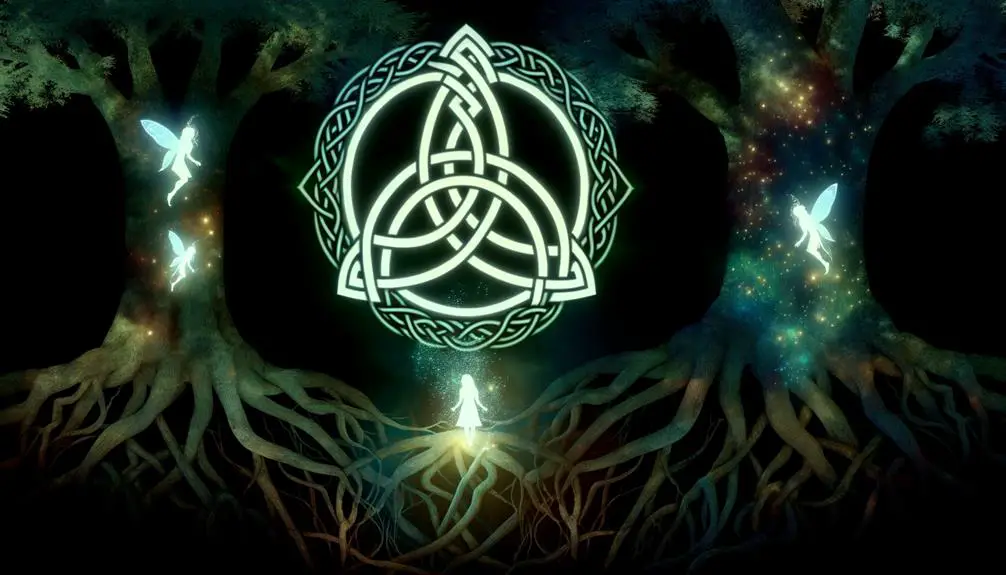
Rooted deeply in Celtic mythology, the Trinity Knot, also known as the Triquetra, serves as a powerful symbol representing the interconnectedness of the natural, spiritual, and human spheres.
This symbol is often linked to the Triple Goddess, embodying the maiden, mother, and crone, each phase reflecting a distinct aspect of life and nature.
Additionally, it is tied to the concept of the three domains: earth, sea, and sky, which were integral to the Celtic worldview.
The endless loop design signifies eternity and cyclical patterns, emphasizing the belief in life's perpetual cycles.
Additionally, its recurring presence in ancient myths and artifacts underscores its significance in conveying complex metaphysical and existential concepts central to Celtic spirituality.
Symbol in Jewelry
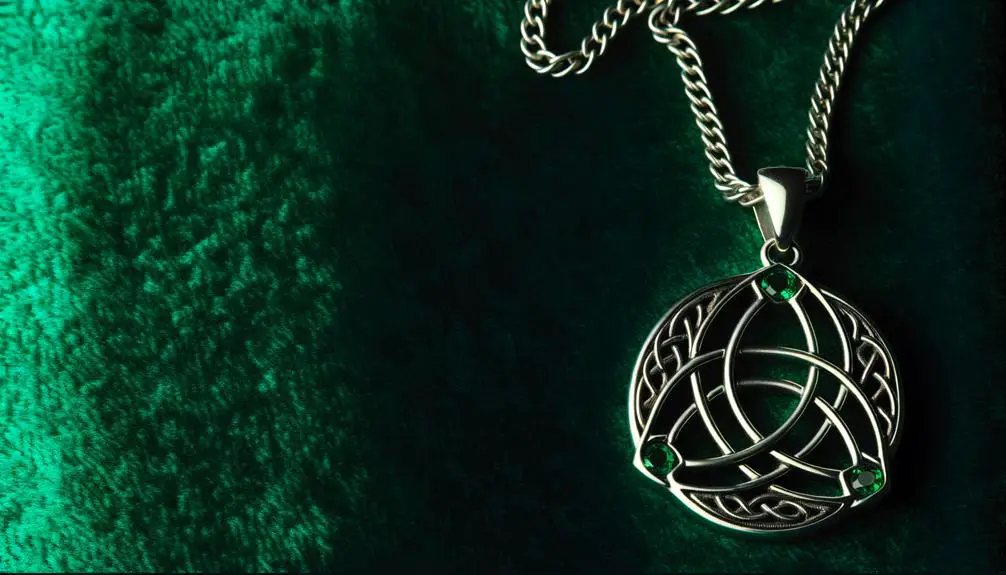
Incorporated into jewelry, the Trinity Knot not only serves as an aesthetic element but also conveys profound cultural and spiritual significance. This iconic symbol, deeply rooted in Celtic tradition, is often chosen for its rich heritage and multifaceted meanings.
In jewelry design, the Trinity Knot can be found adorning various pieces, each reflecting its unique symbolism:
- Eternal Love: Often given as a token of undying affection, representing the interwoven paths of the giver and receiver.
- Spirituality: Emblematic of the Holy Trinity, it serves as a reminder of faith and divine connection.
- Heritage: Celebrates Celtic ancestry and the continuity of tradition.
- Unity: Symbolizes the interconnectedness of life, nature, and the cosmos.
Thus, the Trinity Knot in jewelry is not merely decorative but a bearer of deep, enduring messages.
Trinity Knot in Literature
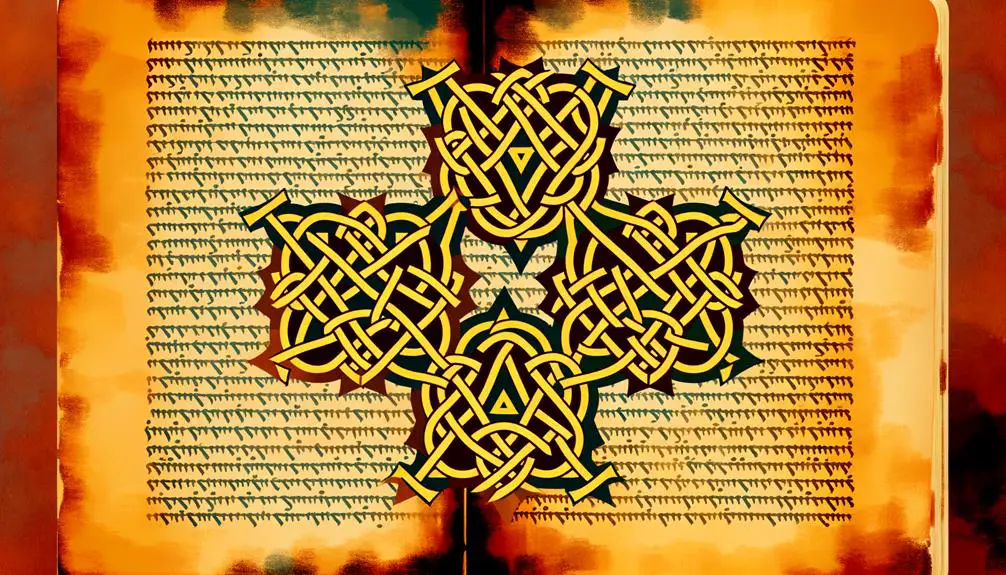
Examining its presence in literature, the Trinity Knot often emerges as a powerful symbol, encapsulating themes of eternity, interconnectedness, and spiritual depth.
In literary works, authors frequently employ the Trinity Knot to signify the triadic nature of existence, such as life, death, and rebirth, or mind, body, and spirit. Its intricate design serves to underscore the complex, interwoven nature of human experience and destiny.
For instance, in Celtic folklore and mythological narratives, the Trinity Knot frequently appears as a motif that bridges mortal and divine domains. Additionally, modern literature may utilize this symbol to evoke a sense of historical continuity and cultural resonance, enriching the narrative with layers of symbolic meaning that invite deeper reflection and interpretation.
Conclusion
The Celtic Trinity Knot, or Triquetra, serves as a profound symbol reflecting historical origins, cultural significance, spiritual interpretations, and artistic symbolism.
Its adaptation by Christianity further enriches its meaning, while various styles and mythological connections highlight its versatility.
For instance, a 9th-century illuminated manuscript, the Book of Kells, exemplifies the intricate use of the Trinity Knot in religious art, symbolizing the intersection of Celtic and Christian traditions.
This enduring symbol continues to captivate through its deep, multifaceted meanings.




